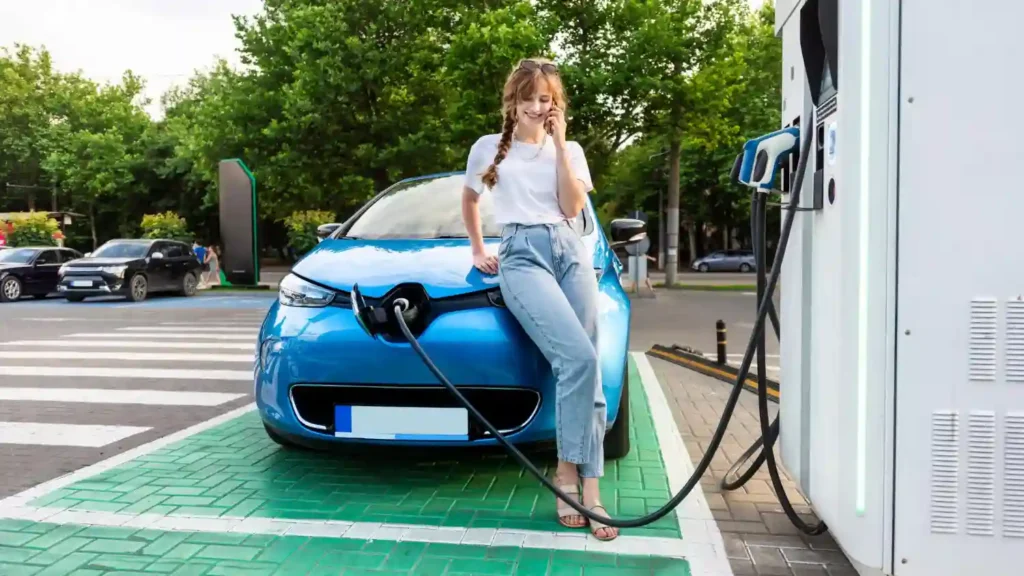Now Reading: The Shocking Truth: Are Electric Cars Better for the Environment?
-
01
The Shocking Truth: Are Electric Cars Better for the Environment?
The Shocking Truth: Are Electric Cars Better for the Environment?

Are electric cars better for the environment? This post dives into the 2025 data. We check the electric vehicle carbon footprint, the EV battery recycling process, and how renewable energy charging stations make them truly green. We explore why electric cars better for the environment are the future of transport.
We all see cars on the road every day. For over one hundred years, most of them have run on gasoline. But this creates a big problem. Gas cars release smoke from their tailpipes. This smoke, filled with greenhouse gases, pollutes our air. It also contributes to climate change.
Now, a new kind of car is becoming very popular. This is the all-electric car, also known as an EV. These cars run on a battery, not on gas. They are quiet and have no tailpipes. Many people say they are the future.
But this leads to a very important question. Are electric cars better for the environment? This is a huge debate. Some people point out that making the batteries uses a lot of energy. Others ask where the electricity comes from.
In this post, we will find the real answers. We will look at the whole story, using the latest 2025 data. We will check the full carbon footprint. We will also explore the batteries and charging. Let’s find out if electric cars are better for the environment.
What is an Electric Car’s Carbon Footprint?
To answer our big question, we first need to understand the electric vehicle carbon footprint. Think of a carbon footprint as a shadow. Everything we make and do, from a t-shirt to a car, has a shadow. This shadow is the total amount of greenhouse gases it creates during its life.
For a car, this life has three main parts. First is manufacturing, which is building the car. Second is its ‘life’ on the road, which is the fuel or energy it uses. Third is its ‘end-of-life,’ or what happens to it when it’s too old to drive.
To know if electric cars better for the environment is true, we must look at all three parts. It is not enough to just look at the tailpipe. The full ‘lifecycle’ tells the real story.
The “Upfront” Cost: Manufacturing the Car
First, let’s talk about the factory. Making any new car, gas or electric, is an energy-heavy job. Factories use huge amounts of power to stamp metal, mold plastic, and assemble parts. This creates a carbon footprint before the car ever drives one mile.
However, with electric cars, there is one extra, big piece. That piece is the lithium-ion battery. These batteries are very large and complex. They need special minerals, like lithium, cobalt, and nickel.
To get these minerals, companies must mine them from the earth. This mining process uses large machines and a lot of energy. As a result, building a new electric car often creates more pollution than building a new gas car. This is the ‘upfront carbon debt’ of an EV.

The “Driving” Benefit: Zero Tailpipe Emissions
But, that is just the beginning of the story. The moment the car leaves the factory, the entire calculation changes. Let’s look at what happens on the road.
A gasoline car must burn fuel to move. Every time you press the gas pedal, the engine burns gasoline. This creates a constant stream of carbon dioxide (CO2) and other nasty pollutants. These gases flow right out of the tailpipe and into the air we breathe.
An electric car, on the other hand, is completely different. It has no gas engine, no fuel tank, and no tailpipe. It runs 100% on the electricity stored in its battery. Because it burns nothing, it produces zero tailpipe emissions. This is a massive win for air quality in our cities.
The “Well-to-Wheel” Debate: Is the Power Clean?
This brings us to the most important part of the debate. The EV itself is clean, but what about the electricity that charges it? This is known as the “well-to-wheel” footprint.
It is true that electricity must be made. In some places, this power still comes from burning coal or natural gas. If you charge an EV using electricity from a coal plant, it is not 100% ‘clean’. There is an indirect footprint.
However, here is the key fact: even on the ‘dirtiest’ power grid, research from 2025 shows that driving an EV still produces fewer emissions than a similar gas car. The efficiency of the electric motor is just that much better.
Above all, the power grid is getting cleaner every single year. This is the most exciting part. More and more of our electricity now comes from renewable sources, like wind turbines and solar panels.
This means that your EV actually gets cleaner over time. A gas car is dirtiest on its first day and stays that way. An EV gets cleaner as the grid that powers it gets greener. This makes the argument for electric cars better for the environment stronger every day.
The Big Question: What Happens to Old Batteries?
Okay, so the car is cleaner to drive. But what about that giant battery after 10 or 15 years? This is a very common and fair concern. We cannot simply throw these batteries in a landfill.
The good news is, we don’t. The battery is the most valuable part of the car. An industry is rapidly growing around the EV battery recycling process. This process is smart, safe, and sustainable.
Step 1: The “Second Life” of an EV Battery
First, an old EV battery is rarely ‘dead’. It is just ‘retired’ from the car. A battery is often retired from a car when it holds about 80% of its original charge. This is not ideal for long-distance driving.
But, a battery that is 80% good is still a very useful battery. Before they are recycled, most EV batteries now enter a ‘second life’. They are reused in other ways.
For example, they are bundled together to create large energy storage packs. These packs can store solar power for a home or business. They can also be used as backup power for hospitals or data centers. This reuse can last for another 10 years.
Step 2: The 2025 EV Battery Recycling Process
After its second life is over, the battery finally goes to a recycling plant. Inside, the battery is carefully taken apart. The goal is to recover the valuable minerals inside.
New recycling methods in 2025 are amazing. Companies can now use processes (like hydrometallurgy) to recover over 95% of the key metals. This includes the lithium, cobalt, and nickel.
These recovered metals are just as pure as brand-new metals. They can then be used to build brand new batteries. This is called “closing the loop” or “urban mining.” We are mining old products instead of the earth. This makes the footprint of a new battery much, much smaller.
Electric Cars vs Hybrids Emissions: A Clear Winner?
Many people wonder about hybrid cars. A hybrid uses both a gas engine and a small electric motor. When you compare electric cars vs hybrids emissions, which one is better?
A hybrid is a good step. It is much cleaner than a car that only uses gas. The small battery helps the car use less fuel, especially in city driving. This means it has lower emissions.
But, a hybrid car still has a tailpipe. It still burns gasoline every day. It is a ‘part-time’ solution.
A full electric car is a ‘full-time’ solution. It has no gas engine at all. When you compare the total lifetime emissions, a full EV is the clear winner. This is especially true when it is charged with clean energy. For those who want to completely stop using gasoline, an EV is the only choice.
Here is a simple breakdown.
| Vehicle Type | Tailpipe Emissions | Fuel Source | Local Air Pollution | Lifetime Carbon Footprint |
| Gasoline Car | High | Gasoline | Yes | High |
| Hybrid Car | Low | Gasoline & Battery | Yes (less) | Medium |
| Electric Car (EV) | Zero | Electricity | No | Low (and getting lower) |
This table makes it clear. When you look at the whole picture, the EV is the best choice. It shows that electric cars are better for the environment when compared to hybrids, too.
The Power of Renewable Energy Charging Stations
The ultimate goal is not just lower emissions. The goal is zero emissions. How do we achieve this? The answer is simple: we must power clean cars with clean energy.
This is where renewable energy charging stations come in. This is the key that unlocks the full promise of an EV. When you plug an electric car into a socket powered by wind or solar, the “well-to-wheel” emissions drop to zero.

This is not a far-away dream. It is happening right now. Many EV owners install solar panels on their roofs. They charge their car during the day with pure sunlight. Their car is literally “running on sunshine.”
Public charging companies are also joining in. Many are building solar canopies over their charging stations. This is one of the most important sustainable transportation trends. It directly connects green energy to green transportation. This makes the statement that electric cars are better for the environment, an undeniable fact.
Sustainable Transportation Trends for 2025
The move to electric cars is part of a much bigger shift. The world is moving toward sustainable transportation. Here are some of the top sustainable transportation trends we are seeing in 2025.
First, battery technology is getting better. Scientists are working on new “solid-state” batteries. These promise to charge faster, last longer, and be even safer than today’s batteries. This will make EVs even more practical.
Second, the public charging infrastructure is growing very fast. Governments and private companies are building new stations everywhere. They are being added to highways, shopping centers, and apartment buildings. This makes it easier for everyone to own an EV.
Third, governments are helping. Many offer electric car incentives, like tax credits. These are discounts that make the cars cheaper to buy. This helps the EV adoption rate climb faster.
All these trends point in one direction. The world is moving away from fossil fuels. More people see that electric cars better for the environment are the smart and responsible choice.
Conclusion: The Road Ahead is Green
So, let’s return to our original, big question. After looking at all the 2025 facts, are electric cars better for the environment?
The answer is a clear and confident yes.
It is true that making an EV, especially the battery, has an upfront carbon cost. But that is where the bad news ends.
Once that car is on the road, it wins big. It has zero tailpipe emissions, which means cleaner air for us to breathe. Its lifetime carbon footprint is far smaller than any gas car.
Furthermore, the old problems are being solved. The EV battery recycling process is turning old batteries into new resources. And as our world uses more wind and solar, EVs get cleaner and cleaner every day.
Choosing an electric car is a powerful vote for a cleaner future. It shows you believe electric cars better for the environment are a key part of the solution. For our planet and for our health, electric cars better for the environment are the best path forward.
FAQs
Yes. Over their full life, EVs have a smaller carbon footprint than gas cars, even with today’s power grid.
Yes, manufacturing the battery has an energy cost. But this is offset by zero driving emissions over the car’s life.
They are given a ‘second life’ for energy storage. After that, new 2025 recycling methods recover over 95% of the metals.
Hybrids are better than gas cars, but they still burn fuel. Full EVs are cleaner as they have zero tailpipe emissions.
Charge your car using renewable energy. This can come from solar panels on your roof or a green energy provider.

Ethan Cole is an American journalist with expertise across weather, tech, travel, and culture. With over 15 years of experience, he delivers sharp, reader-friendly stories that simplify complex topics and connect with audiences worldwide.
Stay Informed With the Latest & Most Important News
Previous Post
Next Post
-
 01Happy Gilmore 2: Your Complete Guide to the Golf Comedy Sequel
01Happy Gilmore 2: Your Complete Guide to the Golf Comedy Sequel -
 02Joe Root’s Test Runs: England’s Batting Genius in Focus
02Joe Root’s Test Runs: England’s Batting Genius in Focus -
 03The Bad Guys 2 (2025): Everything We Know So Far
03The Bad Guys 2 (2025): Everything We Know So Far -
 04Demon Slayer: Kimetsu no Yaiba The Movie: Infinity Castle Tickets – Your Guide to the Epic Anime Event
04Demon Slayer: Kimetsu no Yaiba The Movie: Infinity Castle Tickets – Your Guide to the Epic Anime Event -
 05RTX 50 Series Unleashed: Next-Gen Gaming Power Awaits!
05RTX 50 Series Unleashed: Next-Gen Gaming Power Awaits! -
 06The Naked Gun 2025: What to Know About the Comeback Comedy Starring Liam Neeson
06The Naked Gun 2025: What to Know About the Comeback Comedy Starring Liam Neeson -
 07Freakier Friday 2025: Full Cast Breakdown, Plot Twists, Musical Throwbacks & Streaming Info
07Freakier Friday 2025: Full Cast Breakdown, Plot Twists, Musical Throwbacks & Streaming Info














